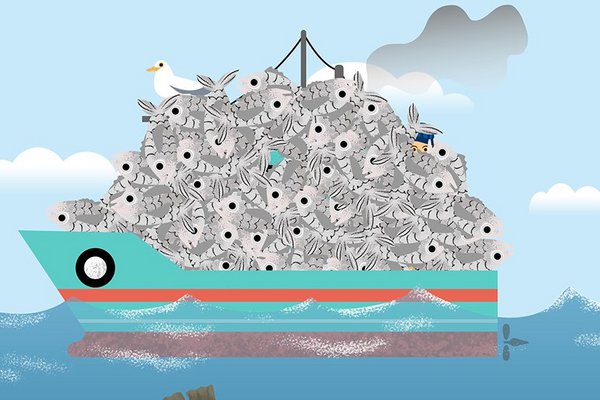We need ambitious protection targets to save our oceans
Our oceans make life on this planet possible - they produce over half the oxygen we breathe, and play a crucial role in absorbing carbon dioxide from the atmosphere, acting as a buffer against climate change. They assist in regulating our weather patterns, and they are a source of food, income, and recreation for people across the planet.
The oceans are also home to over 500 000 known species, representing one of the most diverse ecosystems on Earth. But marine biodiversity is in crisis. According to many experts, we are in the middle of the 6th mass extinction, which is happening with alarming intensity and speed. In the last 50 years, populations of marine species have declined by half. More than one third of the world's marine mammals are threatened with extinction. Scientists estimate about 70 to 90% of all coral reefs will disappear in the next 20 years.
And our oceans and marine life are under more stress than ever. This is due to the increasing effects of climate change, but also relentless exploitation through overfishing, offshore drilling and the growing ‘blue economy, ‘as well as marine litter and industrial and agricultural pollution.
A decade for ocean protection
To change that, we have to act boldly and urgently, prioritising the needs of our planet over profit. In particular, what we do in the next decade will be crucial.
Scientists and NGOs are calling on world leaders to protect at least 30% of the global oceans by 2030. Currently, less than 8% of the oceans are covered by protected areas. The 30% target is backed by extensive scientific research that shows that, by giving life in the oceans space to recover, we can replenish marine populations and reinforce the oceans’ ability to act as carbon sinks, which will in turn make the entire planet more resilient against the worst consequences of climate change.
Increasing the percentage of marine protected areas would also provide greater food security, as well as economic benefits. Despite the common perception that marine protection happens at the expense of fishers, scientific research and practical case studies show fishers can benefit from the so-called ‘spillover effect’. As marine populations recover within marine protected areas, they move outside their borders and into nearby fishing grounds. A recent study suggests that protecting 30% of the oceans would increase the annual global catch by 10%.
Of course, marine protection must be complemented by measures to enable a shift from destructive fishing practices, such as bottom trawling, to more selective and low-impact fishing methods. Small-scale fishers can also play a crucial role in marine protection as partners - they should be actively involved in designation, monitoring, and management of protected areas.
A ‘Paris moment’ for biodiversity
A growing number of governments recognise the need for a better protection of our oceans. This means 2021 can be a ‘Paris moment’ for biodiversity. The big milestone will be the COP15 summit, or 15th meeting of the Conference of the Parties, to the Convention on Biological Diversity taking place in October this year. At the summit, global governments are expected to adopt a post-2020 framework that sets the course for global action on biodiversity in the next 10 years.
The European Commission has already committed to the 30% target through the EU Biodiversity Strategy 2030 that was published in May last year. The 30% target has also been endorsed by more than 50 countries across the world who have joined the so-called High Ambition Coalition. Notably, after years of backsliding on environmental policy, the US has committed to the target as well, through an executive order President Biden signed in January this year.
This political will is also reflected in the draft of the post-2020 global biodiversity framework, although the draft does not specify that the 30% target refers to 30% protected areas both on land and at sea. Marine protection is usually not at the forefront of discussions on protected areas, which is why it is important that the framework makes it clear that the world’s oceans will be protected in line with scientific consensus.
Strict protection backed by science
In addition to the 30% target, a more contentious issue is what this protection would entail. Protected areas range from strictly protected ‘no-take zones’ where only minimal human activity is allowed (such as collecting scientific data) to areas that exclude only the most harmful human activities.
Research has consistently shown that the stricter protection levels yield the highest conservation benefits and that the increase in marine populations is greater in strictly protected areas than in areas where extractive activities are still allowed. No-take zones can multiply up to 6 times the abundance of fish compared to unprotected waters. A greater level of protection is especially important for areas of particularly high biodiversity, known as ‘biodiversity hotspots’, as well as particularly vulnerable species and habitats.
Globally, only a small percentage of the oceans are under strict protection, and many protected areas are only protected on paper. In 2019, while 12.4% of the seas in Europe were designated for protection, only 1,8% were protected in reality. With more awareness of how widespread these so-called ‘paper parks’ are, conservationists are calling for more focus on ensuring protected areas are truly protected from harmful activities.
A global effort to save our oceans
The European Commission has proposed, in addition to designating 30% of the oceans as protected areas by 2030, to ensure that one third of those areas (10%) is strictly protected. The Commission is also working on a legal definition of ‘strict protection’ at the EU level. This is an important signal from the EU ahead of the COP15, although the same level of ambition is not seen on the global level. So far, the draft of the post-2020 global biodiversity framework does not include any targets on strict protection.
Of course, protection targets must always be complemented by effective management of protected areas, and action to reduce the drivers of biodiversity loss.
Scientists have stressed that protection targets are necessary for our survival and the survival of our planet. If we act decisively now, and effectively protect large areas of our oceans from harmful activities, we can still halt biodiversity loss and save our oceans.







![[Translate to English:] Zeichnung von einem Mann und einer Frau mit der Überschrift Bety y Jyri.](/fileadmin/_processed_/5/1/csm_230614_BetyJyri-Website_96cba086d2.jpg)